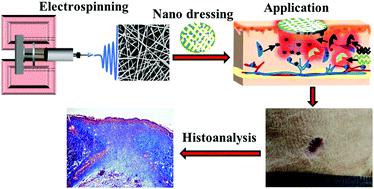当前位置:
X-MOL 学术
›
J. Mater. Chem. B
›
论文详情
Our official English website, www.x-mol.net, welcomes your
feedback! (Note: you will need to create a separate account there.)
Exploration of the antibacterial and wound healing potential of a PLGA/silk fibroin based electrospun membrane loaded with zinc oxide nanoparticles
Journal of Materials Chemistry B ( IF 6.1 ) Pub Date : 2021-1-6 , DOI: 10.1039/d0tb02822c Atta ur Rehman Khan 1, 2, 3, 4, 5 , Kai Huang 6, 7, 8, 9, 10 , Zhao Jinzhong 6, 7, 8, 9, 10 , Tonghe Zhu 5, 11, 12, 13, 14 , Yosry Morsi 15, 16, 17, 18 , Ali Aldalbahi 19, 20, 21, 22, 23 , Mohamed El-Newehy 19, 20, 21, 22, 23 , Xiaoyu Yan 6, 7, 8, 9, 10 , Xiumei Mo 1, 2, 3, 4, 5
Journal of Materials Chemistry B ( IF 6.1 ) Pub Date : 2021-1-6 , DOI: 10.1039/d0tb02822c Atta ur Rehman Khan 1, 2, 3, 4, 5 , Kai Huang 6, 7, 8, 9, 10 , Zhao Jinzhong 6, 7, 8, 9, 10 , Tonghe Zhu 5, 11, 12, 13, 14 , Yosry Morsi 15, 16, 17, 18 , Ali Aldalbahi 19, 20, 21, 22, 23 , Mohamed El-Newehy 19, 20, 21, 22, 23 , Xiaoyu Yan 6, 7, 8, 9, 10 , Xiumei Mo 1, 2, 3, 4, 5
Affiliation

|
Zinc oxide nanoparticles (ZnO NPs) are known for their antibacterial, antioxidant, and anti-inflammatory activities. Moreover, ZnO NPs can stimulate cell migration, re-epithelialization, and angiogenesis. All these attributes are highly relevant to wound healing. Local administration of ZnO NPs to the wound can be achieved through electrospun nanofibers. We hypothesized that the use of poly(lactide-co-glycolic acid) (PLGA)/silk fibroin (SF) nanofiber-based delivery of ZnO would maintain the bioavailability of NPs on the wound area and synchronization with the unique structural features of electrospun nanofibers, could stimulate wound closure, re-epithelialization, collagen deposition, cellular migration, and angiogenesis. In this study, we fabricated PLGA/SF (PS) nanofibrous (NF) membranes with and without ZnO NPs and extensively characterized them for various physicochemical and biological attributes. Scanning electron microscopy (SEM) revealed smooth fibers and ZnO concentration-dependent increase in the fiber diameter. Transmission electron microscopy (TEM) also confirmed the encapsulation of ZnO NPs in the polymer matrix. The successful loading of ZnO was further confirmed by X-ray diffraction. Furthermore, mechanical testing revealed a ZnO concentration-dependent increase in the tensile strength. Moreover, biocompatibility was evaluated through in vitro cell culture. A mild anti-oxidant activity was also noted mainly due to the presence of silk fibroin. In vitro antibacterial tests revealed a ZnO concentration-dependent increase in antibacterial activity and PLGA/SF/3% ZnO (PSZ3) remained completely active against E. coli and S. aureus. More importantly, NF membranes were evaluated for their in vivo wound healing potential. The PSZ3 NF membrane not only facilitated the early wound closure but also remarkably enhanced the quality of wound healing confirmed through histopathological analysis. Re-epithelialization, granulation tissue formation, collagen deposition, and angiogenesis are some of the key parameters significantly boosted by ZnO loaded composite NF membranes. Based on extensive characterization and biological evaluation, the PSZ3 NF membrane has turned out to be a potential candidate for wound healing applications.
中文翻译:

探索载有氧化锌纳米粒子的PLGA /丝素蛋白基电纺膜的抗菌和伤口愈合潜力
氧化锌纳米颗粒(ZnO NPs)具有抗菌,抗氧化和抗炎的作用。此外,ZnO NPs可以刺激细胞迁移,重新上皮形成和血管生成。所有这些属性与伤口愈合高度相关。ZnO NPs对伤口的局部给药可以通过电纺纳米纤维来实现。我们假设,使用聚(丙交酯共-乙醇酸(PLGA)/丝素蛋白(SF)纳米纤维为基础的ZnO输送将维持伤口区域NP的生物利用度并与电纺纳米纤维的独特结构特征同步,可刺激伤口闭合,上皮再生,胶原蛋白沉积,细胞迁移和血管生成。在这项研究中,我们制造了具有和不具有ZnO NP的PLGA / SF(PS)纳米纤维(NF)膜,并对它们的各种理化和生物学特性进行了广泛表征。扫描电子显微镜(SEM)显示出光滑的纤维和ZnO浓度随纤维直径的增加。透射电子显微镜(TEM)也证实了ZnO NPs在聚合物基质中的包裹。X射线衍射进一步证实了ZnO的成功负载。此外,机械测试表明,ZnO浓度取决于拉伸强度。此外,通过以下方式评估了生物相容性体外细胞培养。还注意到温和的抗氧化活性,主要是由于存在丝素蛋白。体外抗菌测试显示,ZnO的抗菌活性呈浓度依赖性增加,并且PLGA / SF / 3%ZnO(PSZ3)仍对大肠杆菌和金黄色葡萄球菌具有完全活性。更重要的是,评估了NF膜的体内作用伤口愈合潜力。PSZ3 NF膜不仅促进了伤口的早期闭合,而且通过组织病理学分析证实了伤口愈合质量的显着提高。再上皮形成,肉芽组织形成,胶原蛋白沉积和血管生成是负载ZnO的复合NF膜显着提高的一些关键参数。基于广泛的表征和生物学评估,PSZ3 NF膜已被证明是伤口愈合应用的潜在候选者。
更新日期:2021-01-20
中文翻译:

探索载有氧化锌纳米粒子的PLGA /丝素蛋白基电纺膜的抗菌和伤口愈合潜力
氧化锌纳米颗粒(ZnO NPs)具有抗菌,抗氧化和抗炎的作用。此外,ZnO NPs可以刺激细胞迁移,重新上皮形成和血管生成。所有这些属性与伤口愈合高度相关。ZnO NPs对伤口的局部给药可以通过电纺纳米纤维来实现。我们假设,使用聚(丙交酯共-乙醇酸(PLGA)/丝素蛋白(SF)纳米纤维为基础的ZnO输送将维持伤口区域NP的生物利用度并与电纺纳米纤维的独特结构特征同步,可刺激伤口闭合,上皮再生,胶原蛋白沉积,细胞迁移和血管生成。在这项研究中,我们制造了具有和不具有ZnO NP的PLGA / SF(PS)纳米纤维(NF)膜,并对它们的各种理化和生物学特性进行了广泛表征。扫描电子显微镜(SEM)显示出光滑的纤维和ZnO浓度随纤维直径的增加。透射电子显微镜(TEM)也证实了ZnO NPs在聚合物基质中的包裹。X射线衍射进一步证实了ZnO的成功负载。此外,机械测试表明,ZnO浓度取决于拉伸强度。此外,通过以下方式评估了生物相容性体外细胞培养。还注意到温和的抗氧化活性,主要是由于存在丝素蛋白。体外抗菌测试显示,ZnO的抗菌活性呈浓度依赖性增加,并且PLGA / SF / 3%ZnO(PSZ3)仍对大肠杆菌和金黄色葡萄球菌具有完全活性。更重要的是,评估了NF膜的体内作用伤口愈合潜力。PSZ3 NF膜不仅促进了伤口的早期闭合,而且通过组织病理学分析证实了伤口愈合质量的显着提高。再上皮形成,肉芽组织形成,胶原蛋白沉积和血管生成是负载ZnO的复合NF膜显着提高的一些关键参数。基于广泛的表征和生物学评估,PSZ3 NF膜已被证明是伤口愈合应用的潜在候选者。











































 京公网安备 11010802027423号
京公网安备 11010802027423号